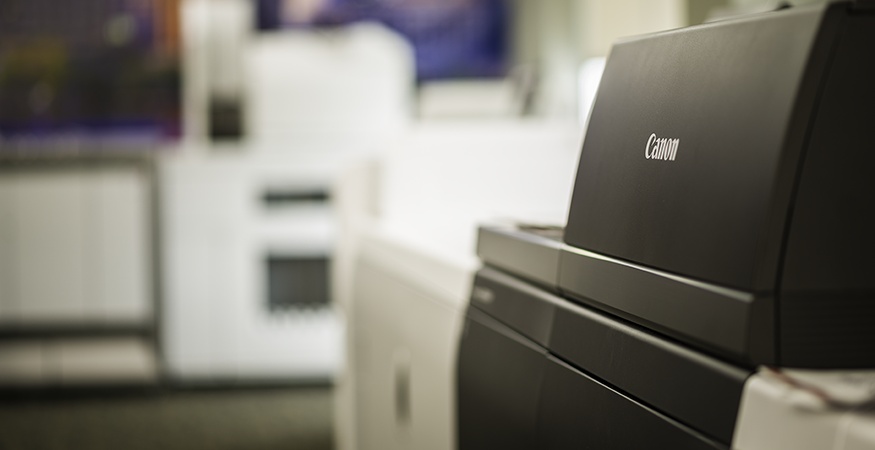Those who use office printers and copiers rely on digital printing every day. But production printers who print large volumes have traditionally used another type of printing technique: offset printing.
That’s changing.
Offset printing has served the printing industry for decades and will always have a role to play for certain print jobs. However, digital print technology closed the gap in quality that once existed between the two types of printing methods. As a result, most print shops are migrating to new digital tools.
Let’s look at the role of offset printing vs. digital printing for commercial printers. As you’ll see, the inevitable shift to digital printing is a trend that will only continue to gain traction.
RELATED RESOURCE: Overcoming the Top 5 Production Print Challenges
What is Offset Printing?
Traditional offset printing uses plates and wet ink on a printing press. This type of printing involves more preparation and setup time, and the final product must dry before finishing can be done, including binding, coating, saddle-stitching, laminating or folding. However, offset printing traditionally produces the highest quality available on the widest variety of paper stocks. In general, it is most economical for large-scale printing operations where.
Offset printing examples:
- Books
- Magazines
- Direct-mail pieces
- Letterhead and envelopes
- Labels
- Business cards
- Packaging
- Flyers and brochures
- And other large-quantity print runs
Offset presses will always have a place in the printing world where high-volume print projects and exact PMS color tones are required. But because the ink can take an extended time to dry, it is slower, more expensive and involves more chemicals than digital printing machines.
What is Digital Printing?
Digital printing is produced directly from electronic files, like a PDF. The printing company doesn’t need to create plates, and set-up time is greatly reduced. Today’s printing customers demand more short-run jobs that are done quickly, including one-off prototypes and samples. Digital presses excel at these types of jobs.
Digital printing works well on most types of media, but there are some jobs where offset printing works better. With recent advances in technology and color management software, however, the printing quality of digital printing is now comparable to offset printing.
Moving away from traditional offset printing also means less mess and fuss. Digital presses don’t use toxic chemicals, making print shops more eco-friendly and safer.
Here are some of the biggest advantages of using digital printing:
Faster turnaround times. Your customers expect to send a print file and get full-color printing flawlessly executed and finished quickly. With less set-up process and calibration, a digital press can meet those demands much more cost-effectively.
Use variable data. Not only is digital faster, but customers can personalize each printed piece for better engagement. Variable data means names, mailing addresses, personalized data and messages can be customized for each printed piece — something that isn’t possible with offset printing.
New inkjet printing processes. New inkjet technology can print on traditional offset stocks with dull, silk, and glossy finishes. High-quality digital presses coupled with color management tools can be as dependable or better than offset printing.
Environmentally friendly. Digital presses use the exact amounts of ink and toner needed, and biodegradable inks and toners are available for more sustainable printing. Digital print also removes the need to wash plates with harmful chemicals at the end of the printing process.
Digital Printing is the Way of the Future
As competition becomes increasingly fierce in the world of printing, digital printers are the only solution for print facilities that need to manage all sizes of print runs while producing vibrant colors and contrasts. Because it dries instantly and offers unlimited personalization (even creating variable pieces in-line), a digital print shop can offer faster and more effective work for clients.
Choosing between digital vs. offset printing is just one of the challenges facing the commercial printing industry. Check out our infographic outlining the top five production print challenges (and tips to overcome them) below.
If you’re exploring new digital printing technology, Gordon Flesch Company can help. We can also help with wide-format printer solutions for sign and display graphics and printing and cutting solutions for small-run printed products to help your print business remain competitive.
To learn more, contact the experts at the Gordon Flesch Company. We are focused on Production Print solutions for commercial printers, and our analysts are ready to help.










